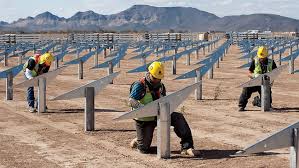Some time in the next few weeks, the first electricity from the first 100MW solar plant in Australia will be sent out to the national grid. The connection of the 102MW Nyngan solar farm in western NSW should finally lift Australia above the likes of the Dominican Republic in terms of large-scale solar. And it might just presage a surge of activity in large-scale solar in Australia.
The Nyngan solar farm – and its sister project, the 53MW solar farm in Broken Hill – are being built because of large grants that were awarded by the federal and state governments to the project developer, AGL Energy. The same is true of the 57MW Moree solar farm, being built by FRV, which will be the first to feature single axis tracking.
Three separate solar projects in the ACT have been, and are being built after bidding the lowest tariff in the territory’s renewable energy auctioning system, part of its plans to deliver 90 per cent renewable energy by 2020.

But now there is movement in other areas too.
Local councils are also investing in solar. Sunshine Coast is developing plans for a 15MW solar plant, and Fremantle has called for tenders for a 10MW solar plant on an old landfill site. Numerous other councils are considering solar as part of plans to make their regions more energy independent.
Miners are also coming to the party. Sandfire Resources has announced plans to build a 10.6MW solar plant at its copper mine in remote Western Australia, along with battery storage. The builder, German firm juwi Renewables, says numerous other miners are looking at solar PV to offset the soaring, and volatile, cost of diesel fuel.
Rio Tinto is building a solar plant with battery storage at its Weipa mine in Queensland, and a Peth-based company is once again canvassing the possibility of building a large scale solar plant near Kalgoorlie, again to provide electricity to miners.

The mega-market is also starting to take shape. Solar Choice broke ground recently with its plans for a huge solar farm in western Queensland that could grow as much as 2GW in stages over the next eight years. It has other projects in mind, too, including near the Whitsunday region.
Canadian Solar recently picked up a 1.2GW large-scale solar portfolio from Recurrent Energy – albeit as a “free option,” thanks to the stalled renewable policy. France’s Neoen bought two undeveloped large scale solar projects from Investec, one near Geraldton and another near Kalgoorlie.
The most activity, however, could be at the smaller end of the utility-scale market. Origin Energy is building a 3MW rooftop solar array – Australia’s largest – on an old Mitsubishi car assembly plant at Tonsley, now a centre for innovative technology. The funding will be backed by power purchase agreements struck with the centre’s tenants. Origin is now looking to see if that model can be repeated elsewhere in the country.
Numerous other companies are looking along the same lines, and solar project developers say there is growing interest from corporates at becoming off-takers for solar arrays, as Apple did with First Solar in a recently announced $US848 million solar project in California. Most are awaiting direction about the future of the renewable energy target.
There are various estimates about how much solar will be built, and how quickly. Mostly it depends on the fate of the renewable energy target. Any delays or extensions to the target will likely mean that solar becomes competitive with wind energy by 2018, or 2019, particularly in solar-rich regions. Any repeal of the target would mean large-scale solar was set back by up to a decade.
“We believe that large-scale solar is on the right side of history – it’s not a matter of if these projects will be built, but when,” Solar Choice CEO Angus Gemmell told RenewEconomy in an interview last week.
The Australia Institute came to a similar conclusion. It says extending the RET to a 30 per cent by 2030 target, as canvassed by the Warburton inquiry, or even lifting it to a 40 per cent target, would allow large-solar PV to enter the Australian energy market on an even larger scale, and take market share away from both wind and fossil fuel energy sources.
“Solar PV is the prime candidate to provide competition to wind as the next low-cost source of large-scale renewable energy generation,” TAI wrote.
“Continued investment in research and development of solar energy technologies, and the ramping up of production capacity in China, Taiwan, Japan, Germany and the United States continues to drive down costs.”
In Australia, though, the cost of building a wind farm will also be influenced by the strength of the local supply chain, and financing costs – which are crucial to any large-scale projects.
Leading industry analysts Bloomberg New Energy Finance agree that solar will rely on the RET initially, but even if the target is cut, or maintained as it is, large-scale solar PV is likely dominate as costs come down.
Last year, BNEF suggested large-scale solar would provide more than half new capacity under the RET in various scenarios. The more the RET is cut, and the more it is delayed, the higher the share of large-scale solar.
If the RET remains in a deadlock, however, it may fall to state and territory governments to fill in the gap. The ACT is preparing to hold a tender for 50MW of “next generation” solar technologies, one that is likely to draw interest from solar towers with storage, and also solar PV and battery storage.











